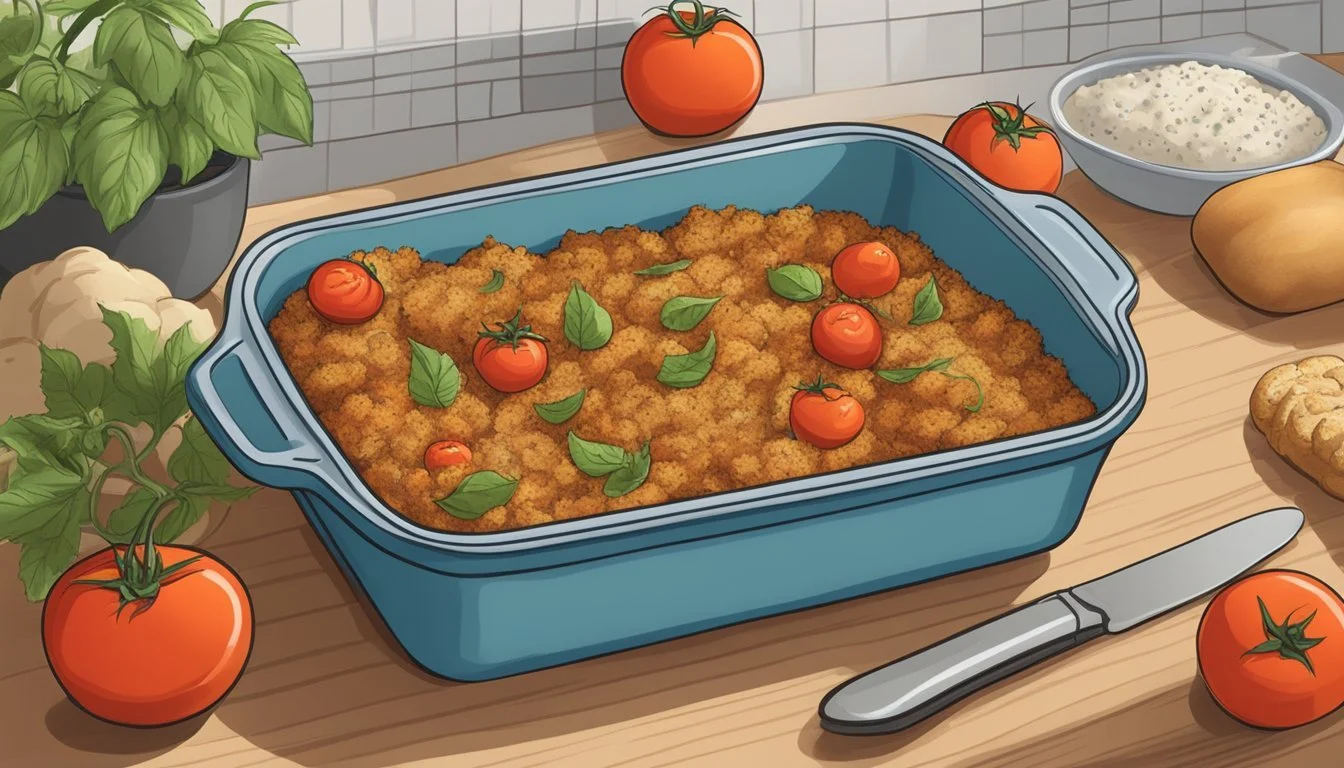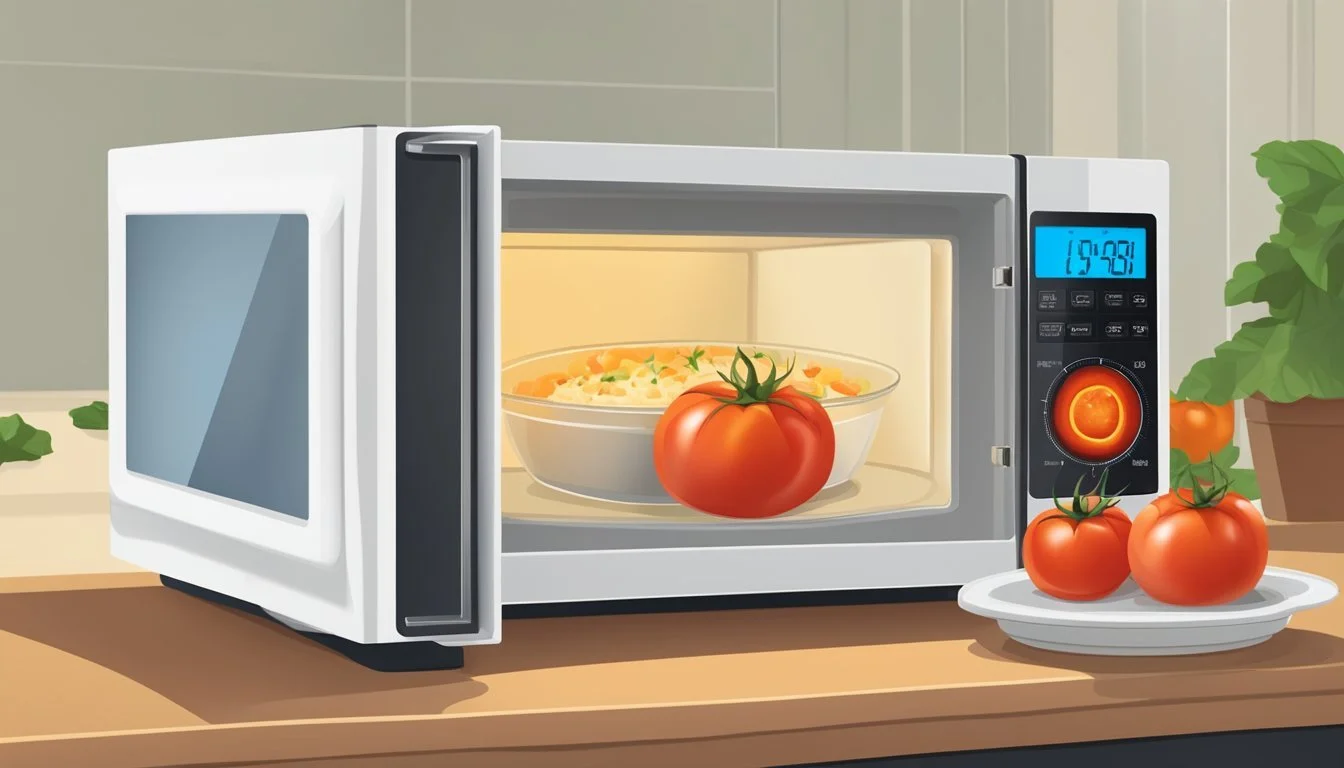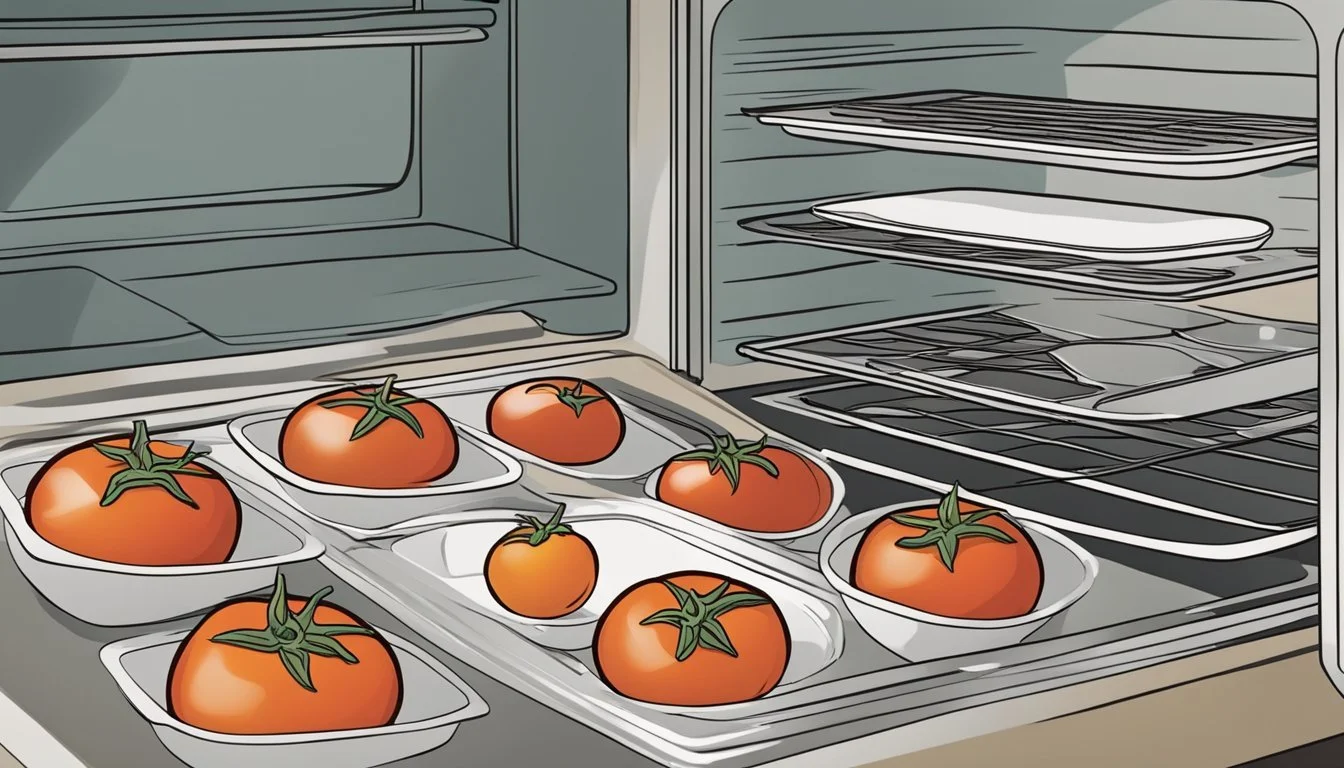How to Reheat Gluten-Free Stuffed Tomatoes
Best Methods and Tips
For those looking to enjoy gluten-free stuffed tomatoes, reheating them to perfection can make all the difference between a delicious meal and a dry disappointment. Properly reheating these tasty treats ensures they maintain their rich flavors and textures, whether served as a dinner entrée or a lovely appetizer. To reheat gluten-free stuffed tomatoes, one should place them on a microwave-safe plate, cover with a damp paper towel, and heat on medium power in 30-second bursts to avoid drying out.
Stuffed tomatoes packed with nutritious ingredients can remain a healthy choice even after reheating. When using the oven, it is essential to preheat to 375°F and bake for 45-60 minutes, adjusting based on the tomatoes' size. This gradual heating allows the tomatoes to retain their moisture and flavor without compromising their gluten-free quality.
These simple techniques guarantee flavorful and healthy meals, making gluten-free stuffed tomatoes an excellent option for any dinner or appetizer lineup.
The Basics of Stuffed Tomatoes
Stuffed tomatoes are versatile and flavorful. This section covers selecting the best tomatoes, ensuring gluten-free ingredients, and understanding their health benefits.
Choosing the Right Tomatoes
Selecting ripe, firm tomatoes is crucial. Ripe tomatoes offer the best flavor, while firm tomatoes hold their shape during cooking.
Heirloom tomatoes provide a robust taste profile. Roma or plum tomatoes are dense and less watery, making them ideal for stuffing. Avoid overripe or mushy tomatoes as they may not maintain structural integrity.
Understanding Gluten-Free Requirements
Ensuring the stuffing is gluten-free is essential. Common ingredients include rice, quinoa, or gluten-free breadcrumbs. Avoid traditional bread crumbs or additives that might contain gluten.
Reading labels carefully helps to prevent cross-contamination. Using fresh or whole-food ingredients ensures better control over gluten content.
Health Benefits of Gluten-Free Stuffed Tomatoes
Gluten-free stuffed tomatoes offer a nutrient-rich option. They are low in calories and saturated fat, with no cholesterol.
Rich in vitamin C, potassium, and fiber, they support immune function and digestion. Adding spinach or chickpeas can boost iron and calcium intake. Stuffed tomatoes also provide a balance of flavor and nutrition, making them a healthy addition to any meal.
Preparation Before Reheating
Ensuring your gluten-free stuffed tomatoes are stored and prepared correctly before reheating can significantly impact the final result. Proper storage and thoughtful preparation steps are essential to maintain flavor and texture.
Proper Storage Techniques
Store gluten-free stuffed tomatoes in an airtight container. This prevents them from drying out and absorbing other odors in the refrigerator.
Refrigeration is key; keep the tomatoes at a consistent, cold temperature.
If you need to store them for longer than a couple of days, freezing is an option. Wrap each stuffed tomato in plastic wrap before placing it in a freezer-safe container.
Label the container with the prep time and date to keep track of freshness.
Pre-Reheat Preparations
Before reheating, take the stuffed tomatoes out of the refrigerator and let them sit at room temperature for about 15 minutes.
Preheat your oven to the recommended temperature. Use a baking dish to hold the tomatoes, and cover them with foil to avoid drying out during reheating.
If using a microwave, place the tomatoes on a microwave-safe plate and cover them with a microwave-safe lid or a damp paper towel. This keeps the moisture intact.
Make sure to check the tomatoes periodically to ensure even heating. Adjust the settings or positioning as necessary to achieve the desired temperature.
Reheating Methods
There are several effective ways to reheat gluten-free stuffed tomatoes to ensure they stay delicious and avoid becoming soggy or dried out. Key methods include using the oven, microwave, and alternative techniques like the skillet or air fryer.
Using the Oven
Preheat the oven to 350°F (175°C). Place the stuffed tomatoes on a baking sheet lined with parchment paper.
Cover them with aluminum foil to retain moisture.
Bake for about 15-20 minutes until the tomatoes are heated through. For a crispy top, remove the foil during the last 5 minutes. This method ensures even heating and helps maintain the tomatoes' texture.
Microwave Reheating
Place the stuffed tomatoes on a microwave-safe plate.
Cover with a microwave-safe lid or a damp paper towel to prevent drying out.
Heat on medium power in 30-second intervals. Check and stir occasionally for even reheating. This method is quick but can make the tomatoes less crispy.
Alternative Reheating Techniques
Skillet: Heat a small amount of oil in a non-stick skillet over medium heat. Place stuffed tomatoes in the skillet. Cook for 2-3 minutes on each side until heated through, which helps preserve their texture and flavor.
Air Fryer: Preheat the air fryer to 375°F. Cook the tomatoes for 5-8 minutes, shaking the basket halfway through. This method keeps them crispy without drying out.
Broiler: Preheat the broiler on high. Place the tomatoes on a baking sheet. Broil for 3-5 minutes, keeping a close eye to prevent burning. This method quickly reheats and crisps up the exterior.
Ingredients and Flavors
A well-made gluten-free stuffed tomato bursts with rich flavors, combining the creaminess of cheese, the aroma of fresh herbs, and various nutritious stuffing ingredients. Attention to these components ensures a delightful culinary experience.
Selecting the Right Cheese
Cheese plays a crucial role in the texture and flavor of stuffed tomatoes. Mozzarella and Parmesan are popular choices for their melty and savory qualities. Mozzarella offers a milder taste and creamy melt. Parmesan, on the other hand, contributes a stronger, nuttier flavor and crisp topping when baked.
For those seeking bolder flavors, feta cheese is an excellent gluten-free option, providing a tangy twist. Each type of cheese serves a different function, enhancing the overall dish in unique ways.
Herbs and Spices for Enhanced Taste
The right blend of herbs and spices elevates the taste of stuffed tomatoes. Oregano, basil, and fresh basil are staples that impart earthy and sweet notes. Garlic and onion provide a robust savory foundation, essential for depth of flavor.
Seasoning with salt and black pepper balances and intensifies these flavors. Additional fresh herbs like parsley add a fresh, green brightness, while dried oregano and basil offer a concentrated herbaceous flavor.
Additional Gluten-Free Stuffing Ingredients
Beyond cheese and herbs, other stuffing ingredients contribute to the dish's richness and nutritional value. Extra virgin olive oil adds a fruity, healthy fat component, making the stuffing moist and flavorful. Pine nuts introduce a buttery crunch, complementing the soft texture of the tomatoes.
Incorporating protein sources like drained chickpeas or veggies such as spinach enhances the nutritional profile and adds variety. Each ingredient should be carefully selected to maintain gluten-free standards while providing a satisfying and delicious experience.
Adherence to these ingredient choices ensures a balanced and flavorful stuffed tomato dish that meets dietary needs.
Serving and Presentation
Proper presentation and thoughtful garnishing of gluten-free stuffed tomatoes can elevate the dining experience. Attention to detail ensures a visually appealing and delicious meal.
Plating Your Stuffed Tomatoes
When plating stuffed tomatoes, use wide, shallow bowls or plates to give each serving its own space. This helps prevent the fillings from spilling over. As these tomatoes can be the main dish or a side, consider portion size.
For a main dish, serve 2-3 stuffed tomatoes per person. For a side dish, one stuffed tomato suffices. Position the tomatoes upright, ensuring the stuffing remains visible and intact.
A light drizzle of vinaigrette on the plate can create contrast and flavor.
Garnishing for Visual Appeal and Taste
Garnishing adds both visual appeal and enhances taste. Fresh parsley sprigs placed strategically can brighten the plate. Sprinkle grated parmesan over the tomatoes for a savory finish.
To add texture, consider toasted breadcrumbs or finely chopped nuts. If tomato season permits, add fresh, sliced tomatoes around the plate for a colorful touch.
A small mound of side salad can complement the dish, with a simple vinaigrette dressing to tie the flavors together.
Nutritional Considerations
Reheating gluten-free stuffed tomatoes can retain their nutritional benefits while maintaining their taste and texture. Understanding their caloric composition and nutrient profile is essential for anyone mindful of healthy eating, particularly those with dietary restrictions.
Caloric and Macronutrient Breakdown
Gluten-free stuffed tomatoes are a nutritious option, often featuring ingredients like quinoa, chickpeas, vegetables, and cheese. An average serving (~1 tomato) contains:
Calories: About 150-200 kcal
Protein: Roughly 5g
Fat: 8-10g, depending on the stuffing and added cheeses
Carbohydrates: Around 15-20g
Fiber: About 3-5g
This meal is low in calories and high in nutrients, making it an excellent choice for a meatless meal or a healthy side dish. The protein content is moderate, primarily from plant sources and cheese, supporting muscle maintenance and overall health.
Micronutrients and Health Impact
Stuffed tomatoes are rich in vitamin A, vital for vision and immune function, and vitamin C, which supports skin health and an immune system.
Additionally, they provide:
Potassium: Helps regulate blood pressure
Iron: Essential for blood production and oxygen transport
Folate: Important for cell division and DNA synthesis
The sodium content can vary, especially if salted ingredients or cheese are used. For a healthier option, minimize added salt. This dish is naturally gluten-free, catering to those with gluten sensitivities or celiac disease, and offers a balanced blend of fiber, healthy fats, and plant-based proteins.
Recipe Variations and Substitutions
There are various ways to adapt stuffed tomatoes to suit different dietary needs and preferences. Whether you prefer a meaty filling or a vegan option, or want to incorporate different grains and vegetables, these variations can enhance your dish's flavor and nutritional value.
Meat and Vegan Options
For those who enjoy meat, ground beef or turkey can be sautéed with onions, garlic, and seasonings before being mixed with rice or breadcrumbs. This provides a hearty and savory filling.
Vegetarians may opt for cheese such as feta or mozzarella combined with the rice filling. Adding mushrooms or spinach can boost the flavor and nutritional content.
Vegan options can include chickpeas or black beans, which add protein and texture. Nutritional yeast can also replace cheese to keep the dish dairy-free.
Pro Tip: Season generously with herbs like oregano, basil, and thyme to enhance the overall taste.
Incorporating Different Grains and Vegetables
Rice is a common stuffing ingredient, but alternative grains like quinoa or brown rice provide different textures and additional nutrients. These grains can be pre-cooked and mixed with vegetables and seasonings.
Pasta can also be used, particularly small varieties like orzo. Stuffed mini bell peppers instead of tomatoes can offer a unique twist.
Vegetables like zucchini, eggplant, and mushrooms can be finely chopped and added to the filling.
Adding corn or peas can add sweetness and color to the dish.
Pro Tip: Roast vegetables like spinach or corn before adding them to the stuffing for a deeper flavor.
Tips for Perfect Gluten-Free Stuffed Tomatoes Every Time
For optimal results, always start with large tomatoes as they offer more filling space.
Gluten-free breadcrumbs or crumbled gluten-free bread provide structure to your filling. They absorb flavors well without compromising texture.
A grapefruit spoon can be very handy for scooping out the tomato flesh without damaging the sides.
Pat the inside of the tomatoes dry with paper towels to avoid excess moisture, ensuring a firm texture after cooking.
Cook time can vary depending on the size of the tomatoes. Generally, 45-60 minutes in a preheated oven at 375°F works well.
Use a large spoon to fill the tomatoes evenly. This helps in sealing all the ingredients inside the tomato shell.
Incorporate shredded mozzarella or another favored cheese. Cheese helps bind the ingredients and adds flavor.
For added richness, a touch of melted butter can be mixed into the filling.
When reheating leftovers, place the stuffed tomatoes on a microwave-safe plate. Cover them with a microwave-safe lid or a damp paper towel to retain moisture.
By following these tips, your gluten-free stuffed tomatoes will be delicious and satisfying every time.










